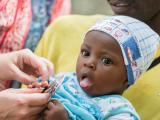A genomic and epidemiologic investigation by scientists with the National Institutes of Health (NIH) has linked a small cluster of multidrug-resistant Sphingomonas koreensis infections at the NIH Clinical Center to the hospital's plumbing system.
The findings of the investigation, which highlights concerns about the presence of waterborne pathogens in hospitals and the risk of transmission to patients, appear today in the New England Journal of Medicine.
The investigation was triggered when six patients at the NIH Clinical Center developed infections with Sphingomonas species, which are ubiquitous in natural and man-made water sources but have rarely been reported in human infections, over a 6-month period in 2016. Four of the isolates were identified as S koreensis, a gram-negative bacterium previously reported in only two clinical cases. A subsequent review of patient records from 2006 through 2016 identified eight additional patients at the hospital with S koreensis clinical isolates.
To assess the genetic relatedness of the isolates, researchers performed whole-genome sequencing (WGS). They also obtained environmental samples from sinks in the rooms of S koreensis patients and performed WGS and shotgun metagenomic sequencing on the isolates to identify a potential reservoir within the hospital infrastructure. Previous studies have implicated contaminated hospital sinks in transmission of carbapenem-resistant Enterobacteriaceae and Pseudomonas aeruginosa.
To determine whether the isolates were unique to the NIH Clinical Center, the researchers compared with S koreensis isolates obtained from other institutions.
The investigation showed that the four S koreensis isolates from 2016 possessed an exceptionally high degree of genetic similarity (>99.92% average nucleotide identity), which suggested they belonged to the same clonal strain, and were resistant to multiple antibiotics. In addition, the eight S koreensis isolates dating back to 2006 shared similar levels of nucleotide identity with one another and with the isolates from 2016 (>99.8% average nucleotide identity).
The researchers also found that 55 S koreensis isolates from faucets and water samples from patient's rooms were genetically similar to the 2016 clinical isolates (>99.7% average nucleotide identity), which implicated the sinks or water as the most likely source of infection (though none of clinical isolates could be perfectly matched to isolates from sinks in patient rooms). Clinical S koreensis isolates from other facilities were genetically distinct from the NIH isolates.
Of the 12 patients, 9 were recipients of stem-cell transplants. Eight of the patients recovered and three died; one of the patients was determined to be either colonized or contaminated with the bacterium. The three patients who died also had severe, unrelated infections.
The researchers suspect that a single S koreensis strain entered the water system soon after construction of a new NIH Clinical Center building in 2004, then disseminated throughout the hospital. No further infections have been reported since remediation efforts were implemented in December 2016.
See also:
Dec 27 N Engl J Med abstract























